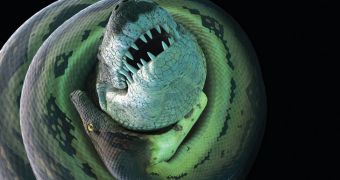A recent paper in the journal Historical Biology describes a newly discovered crocodile-like species that inhabited the Earth millions of years ago and that researchers have named after the fiery Balrog that Gandalf the Grey got to wrestle with in “LOTR.”
As detailed in the paper in the journal Historical Biology, Anthracosuchus balrogus could grow to measure as much as 16 feet (4.8 meters) in length, Live Science informs.
What's more, its waistline would have probably prevented it from making it on the cover of Sports Illustrated's Swimsuit Issue. Thus, these ancient beasts are estimated to have weighed about 900 pounds (408 kilograms), the same source details.
Information shared with the public says that the existence of this previously unknown crocodilian species was documented with the help of fossil remains unearthed at the site of a coal mine in northern Columbia.
For those who haven't figured it out just yet, the fact that these 60-million-year-old remains were uncovered at the site of a mine was the reason why this extinct crocodilian species has landed the name Anthracosuchus balrogus.
Interestingly enough, the four Anthracosuchus balrogus specimens scientists have until now managed to dig out appear to have spent the past several million years accompanied by remains belonging to long-lost and seriously oversized turtles whose shells were as thick as books.
Besides, specialist Jonathan Block says that skeletons originating from snakes measuring a whopping 48 feet (14.6 meters) in length have also been uncovered at this archaeological site in northern Columbia over the years.
Based on the distribution of these fossil remains, it might be that Anthracosuchus balrogus used to feed on turtles and turn to battling ginormous snakes to make the time pass, Jonathan Block and fellow researchers suspect.
As explained in the journal Historical Biology, Anthracosuchus balrogus was part and parcel of a family of crocodilian species known as dyrosaurids. These creatures were a common sight on our planet about 75 million years ago and even managed to outlive dinosaurs.
“This group offers clues as to how animals survive extinctions and other catastrophes. As we face climates that are warmer today, it is important to understand how animals responded in the past,” specialist Alex Hastings comments on the importance of this discovery.
“This family of crocodyliforms in Cerrejón adapted and did very well despite incredible obstacles, which could speak to the ability of living crocodiles to adapt and overcome,” the postdoctoral researcher at Martin Luther Universität Halle-Wittenberg adds.

 14 DAY TRIAL //
14 DAY TRIAL //